Getting Around, Kenya Travel, Transport and Car Rental
(Kenya, KE, East Africa)
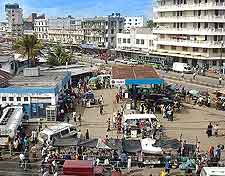
Travelling around Kenya is relatively easy, with options to fly, drive, take a taxi or go by bus transport. Perhaps the most convenient form of transportation, if time is particularly precious, is air travel. However, if you value your freedom and flexibility, hiring a car may be your best bet.
Budget travellers will probably opt for shared taxis and buses, not just because they offer quite good value for money, but also because they give travellers the chance to experience the real Kenya and its people. Train transport is also on hand for longer journeys between the main Kenyan cities and towns.
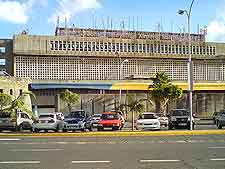
Jomo Kenyatta International Airport (NBO) / Arriving by Air
Address: Airport South Road, Nairobi, Kenya, KE, Africa
Tel: +254 20 661 1000
Nairobi's Jomo Kenyatta International Airport (formerly Embakasi Airport) is a major air hub, with flights operating to and from most major European, American, African and Asia-Pacific destinations. Situated some 15 km / 9 miles south-east of the centre of
Nairobi, travellers can opt to take a taxi.
The much smaller Wilson Airport, located just to the south of Nairobi, offers domestic flights. Other important air facilities in Kenya are as follows:
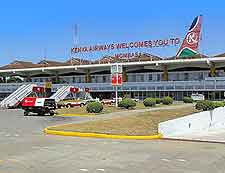
- Amboseli Airport (ASV) - Amboseli
- Bamburi Airport (BMQ) - Bamburi
- Eldoret International Airport (EDL) - Eldoret
- Eliye Springs Airport (EYS) - Eliye Springs
- Garissa Airport (GAS) - Garissa
- Hola Airport (HOA) - Hola
- Kalokol Airport (KLK) - Kalokol
- Kericho Airport (KEY) - Kericho
- Kerio Valley Airport (KRV) - Kimwarer
- Kilaguni Airport (ILU) - Kilaguni
- Kisumu Airport (KIS) - Kisumu
- Kitale Airport (KTL) - Kitale
- Kiwayu Airport (KWY) - Kiwayu
- Lodwar Airport (LOK) - Lodwar
- Loiyangalani Airport (LOY) - Loiyangalani
- Lokichogio Airport (LKG) - Lokichogio
- Malindi Airport (MYD) - Malindi
- Manda Airport (LAU) - Lamu
- Mandera Airport (NDE) - Mandera
- Mara Serena Airport (MRE) - Masai Mara
- Marsabit Airport (RBT) - Marsabit
- Moi International Airport (MBA) - Mombasa
- Moyale Lower Airport (OYL) - Moyale
- Nakuru Airport (NUU) - Nakuru
- Nanyuki Airport (NYK) - Nanyuki
- Nyeri Airport (NYE) - Nyeri
- Samburu Airport (UAS) - Samburu
- Wajir Airport (WJR) - Wajir
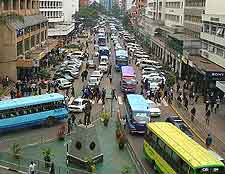
Car Rental
Hiring a car is a good idea if you would like to travel around Kenya with more freedom than public transport would allow or are looking to visit more out-of-the-way destinations, including game reserves. Roads in Kenya are mostly in good condition. That said, it is worth paying extra to hire a more expensive four-wheel drive vehicle, particularly during the rainy season when roads can deteriorate. Cars can be hired in Nairobi, Mombasa and Malindi, and at Nairobi Airport.
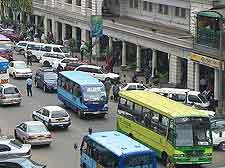
Buses and Coaches
Getting around Nairobi by bus isn't a particularly comfortable experience. However, it is generally quite cheap and convenient. Whilst bus operators may come and go, there are usually two or three serving the city at any one time.
Outside Nairobi, buses travel fairly regularly between Kenya's main towns and cities, including Mombasa, Kisumu and Eldoret. The trip to Mombasa can take anywhere up to eight hours. Whilst this might be a little on the slow side, and comfort isn't on the agenda, bus transport does provide good value for money and suits those on a tight budget. Tickets can usually be bought in advance from individual bus company's ticket offices. Night services also operate between some towns and cities.
Trains
Train travel offers several advantages over other forms of transport in Kenya. Trains are by far the safest way of getting around. Opt for first or second class tickets, and you are also likely to be travelling in style, with a comfortable bed and good meals to look forward to. And whilst train journeys are relatively slow and may be subject to delays, you will find that you have plenty of time to drink in the scenery between such destinations as Mombasa and Nairobi, or Kisumu. From Nairobi, smaller branch line services also operate to Taveta, Nanyuki and Butere. These tend to be less reliable, so it is worth checking in advance whether a service to a particular town still operates.
Taxis
Kenya has an abundance of private minibuses, taxis and 'matatus' (shared minibuses), all of which are popular ways of getting around its towns and cities. Matatus are by far the most commonly used form of transport - they're certainly easy to spot with their colourful paintwork and compulsory yellow stripe. They tend to pick up from fixed spots within a town and only leave when they have a full complement of passengers. The destination of a particular matatu is generally printed on the side of the vehicle. Of note, always check the fare to be charged before you leave on your journey. Some visitors may prefer to pay extra in order to travel in more comfort than can be offered by a shared minibus or to simply avoid hanging around.
 Travelling around Kenya is relatively easy, with options to fly, drive, take a taxi or go by bus transport. Perhaps the most convenient form of transportation, if time is particularly precious, is air travel. However, if you value your freedom and flexibility, hiring a car may be your best bet.
Travelling around Kenya is relatively easy, with options to fly, drive, take a taxi or go by bus transport. Perhaps the most convenient form of transportation, if time is particularly precious, is air travel. However, if you value your freedom and flexibility, hiring a car may be your best bet.




